Angela Ackerman's Blog: Writers Helping Writers, page 26
February 13, 2024
Four Must-Haves in the First Two Paragraphs of Every Chapter or Scene
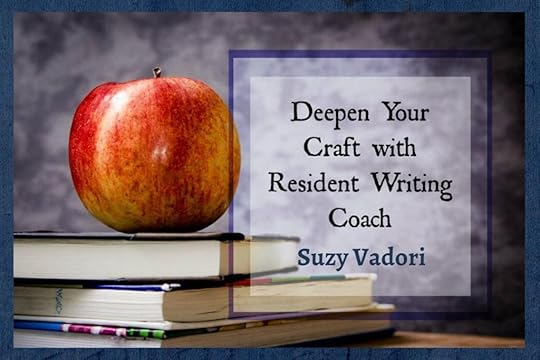
Have you ever been running late, and found yourself scrambling around your house, looking for your car keys? Where did you leave them ��� on the kitchen counter? By the front door? Oh wait, you went up to your bedroom to get something. You race up the stairs, step into your room, and then stop short. You blink. You made your bed already. The blinds are drawn.
What were you looking for, again? For the life of you, you can���t remember.

This is a real phenomenon, so if you���ve experienced this, it doesn���t mean that you���re losing your marbles. It���s called The Doorway Effect, and it happens because as soon as you step over the threshold to a new room in your house, your brain has new information to process, and it clears its slate to ground itself in your new environment.
I���m in my bedroom now. My bed is made. I closed the blinds.
It might be a minute or two before you remember you were looking for your keys. You might need to retrace your steps. (But don���t worry, you���ll eventually remember that they���re on your nightstand, and you���ll leave your house only a few minutes late).
You���re probably wondering what this Doorway Effect has to do with writing? Here���s the cool thing about brains – your reader experiences a similar phenomenon when you cut to a new chapter or scene in your book. As the writer, you have the power to take them anywhere when you start a new chapter or scene. You can jump backward in time, dropping into a flashback, skip forward in time by days, months, years, even decades. You can change whose Point of View (POV) you���re telling the story from, you can even start a new scene on the moon if that���s where your story goes.
And your reader is along for the ride. They trust you, the writer, to lead the way. So, as they cross the threshold into your brand new chapter or scene, that they���ve never read before, they clear their slates, and look for clues to ground them in the scene that���s about to unfold. As they ease into the new scene, they���ll be looking to orient themselves, and need the answers to these questions, fast:
Whose head are they in now? (POV)Where are they in time, relative to the scene they just left?What���s around your characters (setting)?Who is in the in the scene when it opens?This is true even if you start the next chapter only moments later, BTW, so you need to clue them in even if your grounding information is the same as the chapter before!

If they don���t get that information, they���ll feel lost, like they���re floating, without their feet firmly planted on the ground. Without this information, especially any details about the setting, the reader will picture your characters in a white room, or against a white wall, going about the activities you pen for them. This is sometimes called White Room Syndrome, or White Wall Syndrome (again, aren���t brains cool?).
Many readers will start skimming to figure this out rather than stay in this no man���s land. So, if you don���t give this information until the top of the second page of your scene? They���ll miss all the amazing things that happen on page one.
The easiest way to fix this is to make sure you���re providing the 4 elements of grounding readers in your scenes within the first two paragraphs after every chapter or scene break. It���s like a big road sign when they step over the threshold to help them find their place in your world, so that they can relax and let themselves be dragged into whatever your characters get up to next.
Tips for Including Grounding in Your ScenesGet creative, and give readers this information as quickly as possible, so you can get on with the story.
Whose head are they in now? (POV)This is especially important when you are writing your book from more than one character���s point of view.
Opening with an inner thought laced with your POV character���s voice, or an action or dialogue from them is the quickest way to establish this.If you start with another character���s actions or dialogue, readers may incorrectly assume that they will be following this new character���s POV in your scene.Where are they in time, relative to the scene they just left?
Immerse your readers in your scene as quickly as possible by letting them in on where you���ve taken them.
Get creative on establishing the time period for your readers. Phrases like moments later, or three months ago, can get boring, and make your grounding feel clunky. Try some of these ideas instead:Show time passing with the character���s growth (longer hair, wrinkles forming, a child growing taller etc.)Demonstrate a change in an object (a jar of peanut butter that empties over time, or a set of swings that shows wear).Reverse these suggestions if you���re jumping backward in time.What���s around your characters (setting)?Rather than describing the setting, have your POV character interact with it to keep the story moving right from the top of the scene. And keep this short ��� adding this information is not an excuse to drop several paragraphs of worldbuilding (info dumping), which can pull readers out of your story.
Give 2-3 specific showing details about the room or landscape you���re dropping readers into.Have your POV character use something in your scene, or move an object around them that fits with their agencyExamples: Have them check the industrial clock on the wall to show urgency, pick up a rock and throw it to show frustration, etc.Setting details are also needed when your characters change locations within a scene or chapter, in addition to the top of your scenes, so use these tips there as well to make sure your readers don���t get lost on your journey!Check out this article by Angela Ackerman for more ideas on how to ground your characters in your reader���s world.
Who is in the scene when it opens?There is nothing more jarring than thinking a character is alone in a scene and having a second character speak up or yell on page two, while standing right beside them, as if they appeared out of thin air.
Don���t simply list everyone who���s around if there���s a crowd. Mention the crowd but then zoom in on one or two specific people to make this pop.Just like the setting details, let your POV character interact with the people in the scene, through dialogue or actions to make it as engaging as possible.It���s easy to check if you���ve grounded your readers at the top of your chapters or scenes, and to add these details if you haven���t got them in the first two paragraphs after a chapter or scene break to create an immersive experience for your readers, and to lead them seamlessly through the story you���ve spent months or even years crafting. Adding this information does not mean that you have to rewrite a scene you���re happy with. When done with creativity and style, your readers will enjoy your story even more, even if they don���t know why.
Grounding your readers in each scene is one of 30+ practical writing strategies Suzy shares in her Wicked Good Fiction Bootcamp. Want more? Sign up for her Free Masterclass, 3 Secrets to Increase Your Chances of Your Book Getting Published to learn more about her Bootcamp.
The post Four Must-Haves in the First Two Paragraphs of Every Chapter or Scene appeared first on WRITERS HELPING WRITERS��.
February 10, 2024
Character Type and Trope Thesaurus: Starving Artist
In 1959, Carl Jung first popularized the idea of archetypes���”universal images that have existed since the remotest times.” He posited that every person is a blend of these 12 basic personalities. Ever since then, authors have been applying this idea to fictional characters, combining the different archetypes to come up with interesting new versions. The result is a sizable pool of character tropes that we see from one story to another.
Archetypes and tropes are popular storytelling elements because of their familiarity. Upon seeing them, readers know immediately who they’re dealing with and what role the nerd, dark lord, femme fatale, or monster hunter will play. As authors, we need to recognize the commonalities for each trope so we can write them in a recognizable way and create a rudimentary sketch for any character we want to create.
But when it comes to characters, no one wants just a sketch; we want a vibrant and striking cast full of color, depth, and contrast. Diving deeper into character creation is especially important when starting with tropes because the blessing of their familiarity is also a curse; without differentiation, the characters begin to look the same from story to story.
But no more. The Character Type and Trope Thesaurus allows you to outline the foundational elements of each trope while also exploring how to individualize them. In this way, you’ll be able to use historically tried-and-true character types to create a cast for your story that is anything but traditional.
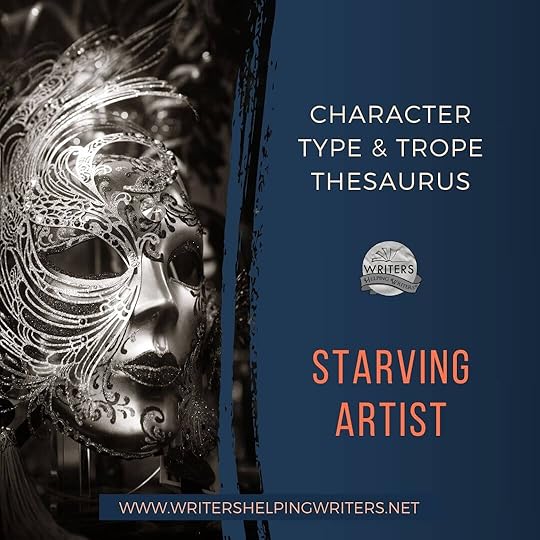
DESCRIPTION: This talented artist is dedicated to a craft that doesn’t meet their financial needs. They are often plagued by self-doubt and struggle to balance artistic endeavors with real-world responsibilities.
FICTIONAL EXAMPLES: Cyrano (Cyrano de Bergerac), Theo Decker (The Goldfinch), Stephen Dedalus (A Portrait of the Artist as a Young Man), Cliff Stern (Crimes and Misdemeanors)
COMMON STRENGTHS: Ambitious, Creative, Disciplined, Focused, Idealistic, Imaginative, Intelligent, Introverted, Observant, Passionate, Pensive, Persistent, Philosophical, Quirky, Resourceful, Talented, Thrifty
COMMON WEAKNESSES: Addictive, Antisocial, Compulsive, Inhibited, Insecure, Irresponsible, Jealous, Needy, Obsessive, Pessimistic, Resentful, Self-Destructive, Stubborn, Temperamental, Withdrawn, Workaholic
ASSOCIATED ACTIONS, BEHAVIORS, AND TENDENCIES
Scorning the system and popular society
Being comfortable with solitude and working alone
Being frugal and thrifty
Being intensely dedicated to their artistic practice
Making sacrifices for their art���e.g., foregoing food or sleep
Feeling misunderstood
Tending toward non-conformity
Sacrificing relationships in the pursuit of their art
Having strong ideas about how art should or shouldn’t be done
Embracing unusual beliefs or ideas; being viewed by others as odd or “out there”
SITUATIONS THAT WILL CHALLENGE THEM
A close friend or loved one becoming more successful than the character
Having to take a hated day job
A publisher, editor, or agent pushing the character to compromise their standards for money
Being pressured by a parent or spouse to give up their dream
Experiencing discrimination that keeps the artist from being accepted
A masterpiece being rejected
TWIST THIS TROPE WITH A CHARACTER WHO���
Had one early success but hasn’t been able to replicate it
Is extremely successful in their day job, which is unrelated to their art
Has an atypical trait: Catty, Devious, Manipulative, Superstitious, Traditional, Sensible, etc.
CLICH��S TO BE AWARE OF
The artist who romanticizes poverty and doesn’t seem to be affected much by it
The artist experiencing a breakthrough and effortlessly creating a masterpiece
The starving artist whose finances don’t match their lifestyle
Other Type and Trope Thesaurus entries can be found here.
 Need More Descriptive Help?
Need More Descriptive Help?While this thesaurus is still being developed, the rest of our descriptive collection (16 unique thesauri and growing) is accessible through the One Stop for Writers THESAURUS database.
If you like, swing by and check out the video walkthrough for this site, and then give our Free Trial a spin.
The post Character Type and Trope Thesaurus: Starving Artist appeared first on WRITERS HELPING WRITERS��.
February 7, 2024
Why Writers Should Be Their Own Valentine This Year
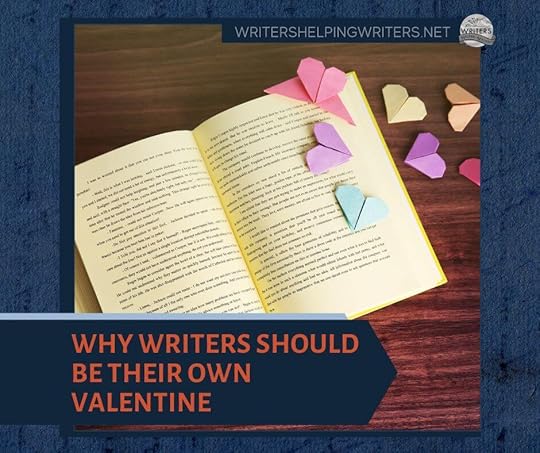
Valentine’s Day is coming, and people have big feelings about it. On one hand, it’s nice to have a set day to celebrate loved ones, but on the other, pressure to buy overpriced chocolates and flowers to ‘show’ love can cast a shadow on things.
Me? I think gifts are nice to give and receive, but pressure shouldn’t be part of it. But on the subject of Valentine’s Day, I have a question for you:
When you’re showing others you care on V-Day, are you giving yourself some of that love, too?
Because you should. You deserve it. Think about how you put a ton of effort into others each day, being the best employee, partner, parent, dog walker, dinner-maker, errand-runner, etc. that you can. It’s who you are, and how you provide for others.
But doing so means there’s not much time for you, is there? And that’s my point, especially for writers.
Our reality is that we need to squeeze writing in around everything else, and after a long day, there’s not always a lot of gas left in the ‘ol mental tank. But we roll up our sleeves because we have books to write and careers to build.
It can be a heavy load.
We need to be kind to ourselves.
So, this Valentine’s Day, think about what you need. And be sure to give yourself these three important gifts:
1) The Gift of Grace
Are you becoming self-critical because you think your writing progress is too slow, you find it hard to manage all the things that come with this career, or right now, certain things are beyond your skill? Let that go. You aren’t a machine, just someone doing their best. Silence your internal critic who is saddling you with unreasonable expectations. Everything takes time to learn. You’re doing great and you’ve got this!
2) The Gift of Time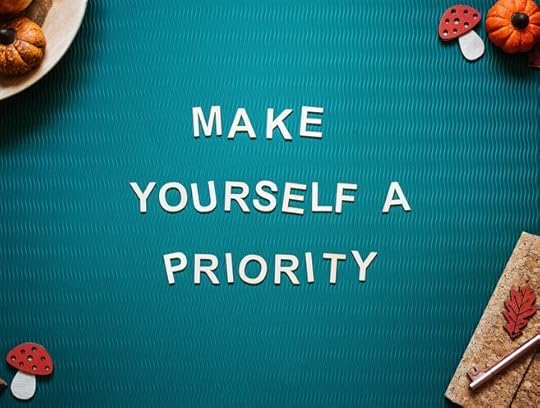
Because you usually put everyone else first, this Valentine’s Day, carve time out for you. Reflect on what is important to you, and what makes you happy. Put those things on the front burner, prioritizing them. Put your needs first.
If you want to be able to write guilt-free, take that time. If you need a break from duty and responsibility so you can do something for yourself, ask someone to step in and help. And while you’re investing in your mental health, consider what small changes will ensure there’s always time for you and what you need moving forward!
3) The Gift of Patience
Because life zips along at a breezy clip, we assume our writing career will too, but it doesn’t work that way. Learning to craft strong novels, understand the industry, build a platform, and become proficient at the business end of things all take time to accomplish.
It’s easy to forget this, especially when others are releasing books and furthering their goals. We feel a sense of urgency to keep up, and falsely believe that if we can’t, something’s wrong with us. Not true. This journey will look different for each of us. And, it’s not a race, so be patient with your progress. Remind yourself that when you rush, bad things can happen.
Remember, it’s okay to put yourself first!This isn’t said enough, and it needs to be!
Many of us feel near-constant pressure to do ‘all the things’ and we try, but it comes at a cost. Neglecting our well-being for too long saps our energy and creativity, and we need both to further our writing goals. And if we start to feel we’re not making headway because we never have time or we’re too tired, doubt creeps in. We may start to worry we don’t have what it takes (and we do!)

This is why self-care is essential. When you invest in yourself, it reminds you that you have WORTH, that those goals of yours are valid and deserve your time and focus.
When you take care of your personal well-being, you feel confident and capable. You have energy for the road ahead. And that’s a win-win-win.
So, as we inch closer to February 14th, think about how you’ll celebrate yourself. Read a book, take yourself on a long walk, and treat yourself to guilt-free indulgence. You deserve it!
Becca and I like to put something together for writers this time of year because we love this community and feel so lucky to be part of it. So if you have been eyeing a One Stop for Writers subscription, please use this 25% off code to save a bit.

SHOW-DON���T-TELL THESAURUS DATABASE
CHARACTER BUILDER
CHARACTER ARC BLUEPRINT
TIMELINE TOOL
STORY & SCENE MAPS
WORLDBUILDING SURVEYS
IDEA GENERATOR
WORKSHEETS & TEMPLATES
THE STORYTELLER’S ROADMAP
All the story support you need to write fantastic fiction, in one place.
To redeem this one-time 25% discount:
1) sign up or sign in
2) Go to Account >> My Subscription and choose any plan
3) Add & activate the VALENTINE code in the box provided
4) Enter your payment details, click the terms box, & hit subscribe
And that’s it. Our storyteller’s toolkit is now your storyteller’s toolkit!
If you are a current subscriber, add/activate this code on the My Subscription page. It will discount your next invoice. Offer ends February 17th, 2024.
What is your favorite type of self-care? Let us know in the comments!The post Why Writers Should Be Their Own Valentine This Year appeared first on WRITERS HELPING WRITERS��.
February 6, 2024
Mastering Turning Points in Relationship Plots
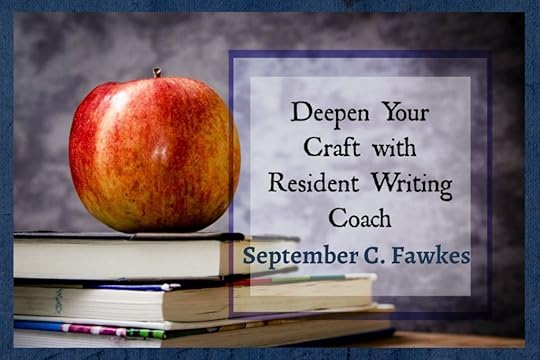
A turning point (also known as a ���plot turn��� or ���plot point���) changes the direction of the story, through an action or a revelation. The protagonist was going one direction, and an event takes place or information is revealed, and the protagonist is now on a different trajectory. Major turning points are often recognized in popular story structures. ���Crossing the Threshold��� in the Hero���s Journey and ���All is Lost��� in Save the Cat are both examples of major turning points. And let���s not forget, the biggest turning point of all, the climax, turns the story from conflict to resolution.
Previously, I discussed how relationship plotlines have the same elements as external plotlines: arcs, goals, antagonists, conflicts, and consequences. They just manifest a little differently.
This is also true with turning points. Relationship plots (whether they be between allies, love interests, or enemies) need turns as well. So, let���s go over their critical components.
1. A Point of No Return
In external plotlines, turning points are often called ���Points of No Return,��� because when handled properly, the protagonist should not be able to go back to how life was previously. He may try, but it���s never the same and his attempts are costly.
In relationship plots, turning points are also ���Points of No Return.��� An event takes place or information is revealed, and it essentially changes the relationship forever. A first kiss, sharing an emotional wound, a punch to the face, a betrayal���these alter relationships in definitive ways.
In Pride and Prejudice, at the midpoint, Mr. Darcy shares he’s in love with Elizabeth and proposes to her. This is both a revelation and an action that can’t be undone. It’s a moment where Mr. Darcy attempts to move closer to Elizabeth, but Elizabeth creates distance. She will never see Mr. Darcy the same way. Their relationship will never truly go back to what it was. It has become more personal.
2. Close or DistantTypically, in external plots, the turn ends in a victory or a failure. In relationship plots, the turn ends in the participants being close or apart. For most relationship journeys, you���ll want major turns of each. A ���break up��� may tear characters apart, while a ���grand gesture��� may bring them close together. This helps create a zigzag effect, so it feels like the relationship is evolving, instead of remaining stagnant or circling the same problems.
It���s also possible to bring close characters closer, or pull distant characters further apart.
You have four options:
Distant –> Close
Close –> Distant
Distant –> More Distant
Close –> Closer
With that said, there is room for complexity. In the Pride and Prejudice example above, Mr. Darcy tries to get close to Elizabeth, but she pushes him away, creating distance. This brings me to the next section.
3. A Vulnerable Moment that is Accepted, Rejected, or Neglected
A relationship turn almost always contains a vulnerable moment. One character is vulnerable, and the other gets to decide how to respond.
The first character���s vulnerability may be voluntary, or it may be forced. It may even be forced by the other character in the relationship.
In Pride and Prejudice, Mr. Darcy shares his vulnerability voluntarily���he confesses he���s in love with Elizabeth.
In contrast, in Harry Potter and the Sorcerer���s Stone, when Hermione is attacked by a troll in the girls��� bathroom, her vulnerable state is involuntary.
And in Star Wars III: Revenge of the Sith, Obi-Wan forces Anakin into a vulnerable state when he cuts him down in the climactic fight.
In the next moment, the second character gets to decide what to do to the first: accept, reject, or neglect them. This is what ultimately turns the relationship.
Elizabeth responds by rejecting Mr. Darcy. They are pushed further apart.
Harry (and Ron) responds by accepting the call to save Hermione. They are brought closer together.
While Anakin lays dying, in need of medical assistance, Obi-Wan neglects him, walking away. This also pushes them further apart. (Neglect can be viewed as a lesser form of rejection.)
It���s important to note that rejecting and neglecting aren���t always bad. What they usually mean is that the second character is unwilling to cross a boundary. Elizabeth isn���t going to agree to marry Mr. Darcy, because she���s unwilling to marry someone she hates. And Obi-Wan isn���t going to help Anakin, because it would harm the whole galaxy.
As with any writing element, there is room for variations, but at the basic level, this is how relationship turning points work.
And just like the external plotline, the turns in the relationship plotline should escalate so that vulnerable moments grow more intense, and the acceptance, rejection, or neglect of them carry bigger ramifications.
If you are looking for more help with your relationship plots, check out my relationship beat sheet. You can also always peruse the relationship thesaurus, too.
The post Mastering Turning Points in Relationship Plots appeared first on WRITERS HELPING WRITERS��.
February 3, 2024
Character Type & Trope Thesaurus: Wallflower
In 1959, Carl Jung first popularized the idea of archetypes���”universal images that have existed since the remotest times.” He posited that every person is a blend of these 12 basic personalities. Ever since then, authors have been applying this idea to fictional characters, combining the different archetypes to come up with interesting new versions. The result is a sizable pool of character tropes that we see from one story to another.
Archetypes and tropes are popular storytelling elements because of their familiarity. Upon seeing them, readers know immediately who they’re dealing with and what role the nerd, dark lord, femme fatale, or monster hunter will play. As authors, we need to recognize the commonalities for each trope so we can write them in a recognizable way and create a rudimentary sketch for any character we want to create.
But when it comes to characters, no one wants just a sketch; we want a vibrant and striking cast full of color, depth, and contrast. Diving deeper into character creation is especially important when starting with tropes because the blessing of their familiarity is also a curse; without differentiation, the characters begin to look the same from story to story.
But no more. The Character Type and Trope Thesaurus allows you to outline the foundational elements of each trope while also exploring how to individualize them. In this way, you’ll be able to use historically tried-and-true character types to create a cast for your story that is anything but traditional.
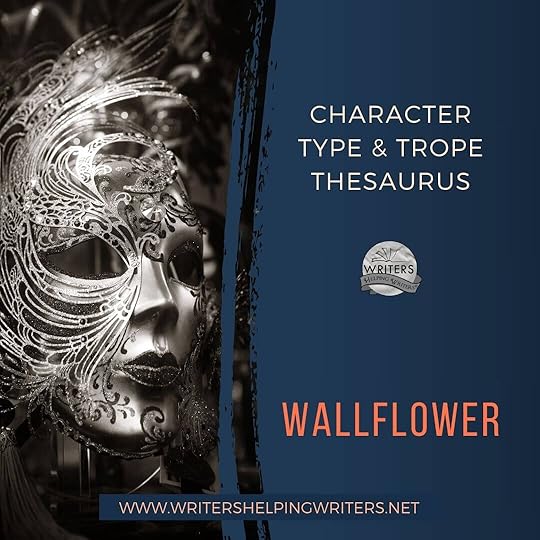
DESCRIPTION: Awkward and shy, wallflowers typically stick to the fringes. Some are happy being in the background while others wish they could break out of their shell and into the spotlight.
FICTIONAL EXAMPLES: Mr. Darcy (Pride and Prejudice), Anne Elliot (Persuasion), Penelope Featherington (Romancing Mr. Bridgerton), Charlie (The Perks of Being a Wallflower), Willow Rosenburg (Buffy the Vampire Slayer)
COMMON STRENGTHS: Cautious, Courteous, Creative, Diplomatic, Discreet, Gentle, Humble, Imaginative, Independent, Introverted, Kind, Observant, Pensive, Perceptive, Private, Responsible
COMMON WEAKNESSES: Cowardly, Evasive, Gullible, Inhibited, Insecure, Nervous, Obsessive, Oversensitive, Pessimistic, Resentful, Timid, Uncommunicative, Weak-Willed, Withdrawn, Worrywart
ASSOCIATED ACTIONS, BEHAVIORS, AND TENDENCIESBeing introverted
Being shy
Disliking small talk
Being a good listener
Having keen observation skills
Choosing hobbies and activities that allow the character to shine privately
Having a vivid imagination
Not engaging, even when they should���in a bullying situation, for instance
Difficulty setting and maintaining personal boundaries
Trusting people they shouldn’t
Being sensitive to crowds, noise, or excessive stimulation
SITUATIONS THAT WILL CHALLENGE THEM
Being in a large social gathering, especially if there is almost no one there they know or feel comfortable with
Having a public misstep put on social media for everyone to see
Being put on display���having to give a speech or sing a solo, for instance
TWIST THIS TROPE WITH A CHARACTER WHO���
Has a hidden well of self-confidence in certain situations or areas of expertise
Has a dark secret that no one suspects
Has an atypical trait: bold, verbose, vain, fanatical, flirtatious, sophisticated, etc.
CLICH��S TO BE AWARE OF
The awkward introvert who must always be rescued from social interactions by others
The frumpy bookworm who undergoes a near-instantaneous transformation to attractive, confident, and refined
Other Type and Trope Thesaurus entries can be found here.
 Need More Descriptive Help?
Need More Descriptive Help?While this thesaurus is still being developed, the rest of our descriptive collection (16 unique thesauri and growing) is accessible through the One Stop for Writers THESAURUS database.
If you like, swing by and check out the video walkthrough for this site, and then give our Free Trial a spin.
The post Character Type & Trope Thesaurus: Wallflower appeared first on WRITERS HELPING WRITERS��.
February 1, 2024
How to Write Your First Book
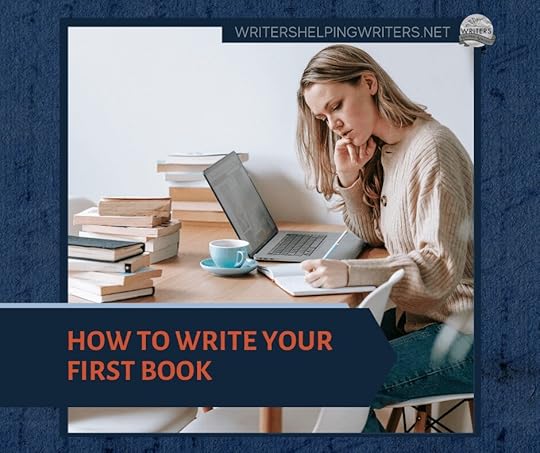
I want to write a book.
You remember when this big idea first hit, right?
Maybe you were browsing for books, waiting for an author���s autograph, or sitting in awe after finishing a great novel. The idea took hold of you, and soon you found yourself buying notebooks, pens, and sticky notes. You browse online for writerly things���a cute laptop sticker or a mug that says, ���Writer at Work.��� And then when it arrives, you fill it with your favorite drink, sit down at your computer, and open up a new document. Because it’s SHOWTIME!
You place your hands on the keyboard, grinning like a clown-obsessed maniac. This is it���the magic is about to happen.
Onscreen, the cursor blinks. And blinks.
Boy, the page is so white. How did you not notice before? And that infernal flickering cursor��� is it just you, or does it seem kind of judge-y?
And that���s when you realize your big idea has a second part to it:

I want to write a book���but I have no idea where to start.
Thankfully, this truth, while inconvenient, doesn���t have to stop any of us from writing. It may seem daunting at first, and doubts might try to sway us (What was I thinking? I can���t do this!), but I���m here to tell you that, yes, you can write a book.
7 Tips for How to Write a Book When You Have No Idea What You���re DoingNot knowing where to start is a problem countless writers before us have faced and figured out. So, if you are feeling a bit lost when it comes to your big dream, these seven things can help you move forward and even better, jump start your writing career.
1. WriteSure, this seems obvious, but starting can be paralyzing. We worry about committing our ideas to the page because what if they resemble some four-year-old���s Cheerios-and-glue ���masterpiece���? Well, guess what? They might, and that���s okay. Great storytelling takes time, and if that didn���t put off Stephen King, Susanne Collins, or Nora Roberts, it shouldn���t stop us, either.
To begin, think about your Big Story Idea. Jot down your ideas, or try outlining the story you envision using one of these methods or this outlining software. Or start with something small, like one scene. At the beginning of a writing journey our goal should be getting comfortable with putting words on the page and having fun, not pressuring ourselves into penning the next Game of Thrones.
2. Read WidelyReading is so enjoyable we tend to forget how each story is a treasure trove of education on what makes a book good, bad, or off-the-charts great. So read widely, thinking about what makes each story compelling. Look for characters that stand out, story worlds that seem so real you feel part of them, and plots that keep you flipping pages long into the night. Ask yourself questions:
What made certain characters larger than life?Did their personalities, complex motives, or a truth they live by pull you to them?What scenes and situations seemed the most real to you?Studying where you fell under the storyteller���s spell can help you see how you can do the same for your readers.
3. Join a Writing Group
One of the best things you can do at the start of this journey is find others on the writer���s path. A community of writers puts you in touch with those who have the same goal, meaning you can learn from and support one another. Plus, having creatives in your circle helps to keep you accountable, meaning your butt stays in the chair and words get written.
4. Collect a War Chest of KnowledgeWe all start with some talent and skill, but to write well we need to train up. Visit Amazon to find writing books with high reviews so you can judge which might be most helpful for your development. Make note of the title or ISBN and order them at your favorite bookstore.
Another way to build your knowledge is by subscribing to helpful writing blogs. Bite-sized learning can be perfect for a time-crunched writer. I recommend exploring all the resources on this page, studying up on character building, story structure, worldbuilding, and everything in between.
Getting to know who the people in our stories are and what makes them tick helps us understand what���s motivating them, and that makes writing their actions and behavior easier. To dive deep into who a character is so you can write them with authority, this tool will help.
5. Take a Course or WorkshopInvesting in guided or self-guided learning can also kickstart your progress. The community is packed with great teachers. Below are some good options, but first, if you belong to a writing organization, check to see if they offer members classes for free or at a discount.
Reedsy Learning CenterBang2Write CoursesLawson Writer���s AcademyJami Gold WorkshopsJerry JenkinsWriting for Life WorkshopsMichael Hauge (Hero���s Two Journeys)6. Look For Step-by-Step HelpAs any writer will tell you, the road from an idea to a publish-ready novel is a long one, and it���s easy to get lost along the way. It���s no fun when we don���t know what to write next, or we don���t know how to solve a problem in the story. And, if we get too frustrated or our writing stalls for too long, we might end up quitting. Having an expert offer guidance as you write can keep you on track.
Some writers like to partner with a writing coach so they get personal feedback and support as they go. If this is something you might like, here���s a list to start with. A benefit is that you���ll learn a lot about writing as you go, but depending on how long you need coaching for it can get a bit costly. So another option might be the Storyteller���s Roadmap at One Stop for Writers. This roadmap breaks the novel-writing process into three parts: planning, writing, and revising. It has step-by-step instructions on what to do as you go, and points you to tools, resources, and articles that will make the job easier.

The Storyteller���s Roadmap also has built-in solutions for the most common writing problems, so whether you need to overcome Writer���s Block, Impostor���s Syndrome, or stop new ideas from derailing your story, the Code Red section keeps you on track.
7. Above All Else, Be FearlessStarting a book can seem like a monumental undertaking, and sometimes with big dreams, we have the tendency to try and talk ourselves out of them. We fear failing, because we think that���s worse than never trying at all. If you feel the passion to write, don���t let fear stop you. The world needs great stories!
The post How to Write Your First Book appeared first on WRITERS HELPING WRITERS��.
January 30, 2024
What Are Your Questions about Writing & the Business Side of Being an Author?

Is it just me or did the month of January fly by? Seems like I was just putting away Christmas decorations and gearing up for the new year.
January’s always a busy time for Angela and me because it’s when we do our annual planning���figuring out what our goals should be and how we should allocate our time. Staying organized is more important than ever because we’re closing in on 16 years of blogging (crazy!), and things are a little busier and more complex at Writers Helping Writers than they were in 2008. So carefully planning our time is key to us staying sane.
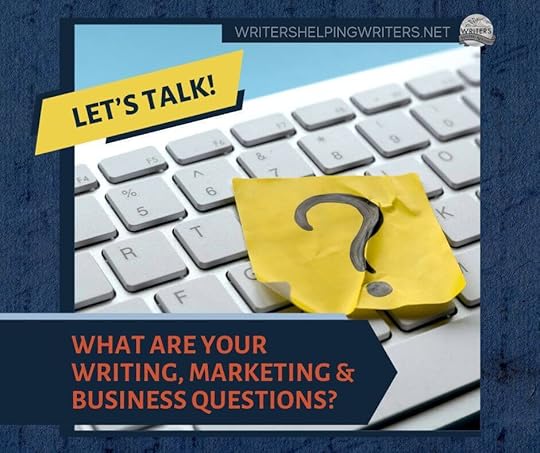
But we still find ourselves looking back sometimes at the things we did when we were first starting out���fun launch events and opportunities that had to be set aside as our responsibilities grew and our time got squeezed.
One thing we miss is being able to answer your questions about writing and the business side of things. Angela and I have been studying writing craft and managing the business end for some time now, so if we have knowledge that can help you, we want to share it. To this end…
We’re bringing back our Q&A!For now, we’ll include the Q & A in our Master Storytelling newsletter (see the latest edition here), and this means we need your questions!
So, is there something you’re struggling with and need help understanding? Or do you have a question about us personally? If so, let us know. To get your brain churning, here are some topics and questions:
Writing Craft and Various Aspects of StorytellingHow do I figure out my character’s wounding event?
What’s the difference between a change arc and a failed arc?
What tips do you have for showing instead of telling?
How do I identify my story’s theme?
How much description should I include when I’m describing my setting?
What nonfiction writing craft books would you recommend?
What story structure model do you like to use, and why?
I have a full-time job; how do I make time for writing?
Should I create a business plan, and how do I do it?
I’m attending a conference this summer. Any tips on maximizing that experience?
What are some ways I can use my writing skills to make money on the side?
How can I use A.I. to save time and maximize my efficiency as a writer?
What’s a mistake you and Angela made on the business side of things, and what would you do differently?
Should I self-publish or go with a traditional publisher? What are the differences?
Do I need an agent?
How do I know my book is ready for submission?
How do I find a critique group?
How do I know what feedback to incorporate into my story and what to ignore?
How do I tell a legitimate publisher from a vanity press?
Do I have to hire an editor?
When should I copyright my work?
Can you recommend a formatter/cover designer/proofreader/etc.?
Why did you and Angela decide to self-publish your books?
How do I gain visibility for my books?
Should I go wide or narrow?
How do I find my ideal reading audience?
What should I write about in my reader-focused newsletter?
What marketing strategies have worked the best for you and Angela?
What’s the difference between your books and One Stop for Writers?
Which of your books should I buy for a friend who’s a beginning writer?
How do I use the Reverse Backstory Tool in Appendix A of The Negative Trait Thesaurus?
I just found your Goal, Motivation, Conflict, & Stakes tracking resource. How do I figure out why they want to achieve their goal?
Will you be turning the Fear Thesaurus into a book?
What was your favorite book to write?
(because all work and no play turns you into this guy).

How do you collaborate on books – what does that look like?
What are your biggest struggles as authors?
Do you have a pet, and can you share a picture of them?
When was the last time you were embarrassed?
How did the two of you meet?
What have you learned about yourselves from writing your series?
Pineapple on pizza: yes or no?
This is just a sampling of the kinds of questions you could ask. Basically, we’re happy to answer anything writing- and career-related that you need help with and share a bit about our personal side, too. (If you have a question about your specific story, we won’t be able to answer those as we’d require a lot of specific knowledge about your project.)
If you’d like to submit a question, please use this form. You can enter up to 3 questions at a time; if you have more than that, just click the link and start a new submission. The more questions the better!
We can’t wait to see what you come up with!
The post What Are Your Questions about Writing & the Business Side of Being an Author? appeared first on WRITERS HELPING WRITERS��.
January 25, 2024
Tension and the Power of Unanswered Questions
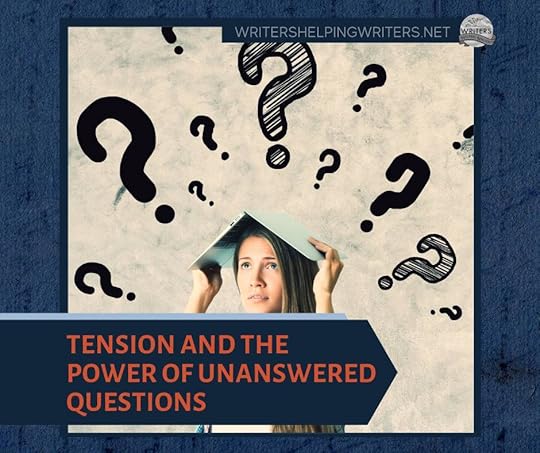
Have you ever been a bit hazy on the difference between conflict and tension? If so, you aren���t alone. It���s common to confuse the two because they���re often used together to deliver a one-two dramatic punch.
The difference between them is subtle, but important:
Conflict is a force that stands between your characters and what they want most.
Tension is the feeling of anticipation surrounding what will happen next.
Conflict is concrete���a roadblock, dilemma, danger, adversary, etc. that represents a real problem for the character. Tension is more under the surface, where less is known. There���s a problem bubbling, potential for disruption, or certain factors are coming together which point toward a specific outcome. But will this outcome be realized? Will the right things happen to create chaos? This ���will it happen or won���t it��� anticipation keeps readers on edge, which is why tension is so good for our story.
We can make good use of the reader���s need to know by building scenes that cater to it. For example, imagine a jerk character in our story who is dating two women, Alice and Shai. Neither is aware of the other, which is just how Logan wants to keep it. But in an epic goof, he asks them both to meet him for dinner at the same restaurant on the same night.
When the women arrive (at the same time, of course), that���s conflict. When they both cross the room, unaware they���re meeting the same man, that���s tension.
Tension draws readers in by causing them to mentally ask questions:
Will the women find out Logan���s dating them both?
Will he worm his way out of it somehow?
What will the women do?
Will there be a big blowout?
Strong tension follows a pattern of pull-and-release���meaning, you let the tension build until it reaches its peak then resolve it by answering some of those unspoken questions.
We���ll imagine that Logan sees the two women. Doom is approaching on stilettos, and he has no idea what to do. One thing is certain, though: when they reach his table, it���s over.
Now, if we wanted to continue building tension, we could add an event that delays the inevitable. Maybe Shai drops a scarf halfway to the table and Alice notices. She retrieves it and stops Shai to return it.
Tension builds as they trade a few words. Logan watches this horror unfold: Will one of them mention me? Point? Will they turn on me with death in their eyes?
Readers know Logan is dead meat���unless we cut him some slack by flipping his tension from negative anticipation to positive.
We can do that by introducing another event.
Perhaps after accepting the scarf, Shai glances toward the restroom. Logan watches, his mind ablaze, hoping against hope she���ll head there, not the table, so that when Alice reaches him, he can quickly make an excuse that he���s sick and they need to leave. Then he can text Shai while she���s in the restroom with a similar explanation for his absence.
Readers watch this new development and think, Will she go to the restroom? Is this his way out?
Anticipation builds and again we achieve pull-and-release by answering internal questions.
As the authors, we decide Shai doesn���t hit the restroom, and so both women arrive at his table at the same time. Sorry, Logan, you jerk. No easy out for you.
After a moment of confusion, the blowout that Logan and the reader have anticipated happens. Shai and Alice start shouting at him, and every diner stops eating to watch the show. Embarrassed, he pleads for them to calm down, which only fires them up. Finally, Alice snatches a bowl of soup from a passing waiter���s tray and dumps it over Logan���s head. Tension is again released.
Shai asks Alice if she wants to get a drink, and the two leave. Logan, dripping chowder, signals for the bill, relieved that the restaurant is far from home and no one he knows will have witnessed this.
This last line provides us with a classic opportunity to use another tool in our tension belt: foreshadowing.��What might that look like?
Perhaps as Logan picks clams off his face, he catches someone filming him with their phone, and he realizes they���ve likely caught the whole, messy scene on video. His guts tightens because he knows nothing good can come of this.

And the reader does too. More internal questions arise:
Will that video show up online?
Will someone see it and recognize him?
As you can see, tension affects both readers and characters. A new situation, threat, or obstacle appears, and provided something���s at stake, an unasked question hangs in the air: What comes next?
Tension can result from all kinds of conflict scenarios, such as when the character���Is wrestling with competing goals, needs, or desires.Must make a decision without all the facts.Is unable to resolve a problem.Is waiting on an outcome.Has no good options.Doesn���t know how bad the fallout will be.Doesn���t know who will pay the price for their actions.Doesn���t know who to trust.Can���t predict how someone will react.Notice the repeated theme here: something is unknown. Exploit that ignorance or uncertainty and let the tension build.
The post Tension and the Power of Unanswered Questions appeared first on WRITERS HELPING WRITERS��.
January 23, 2024
The One Rule No Writer Should Break
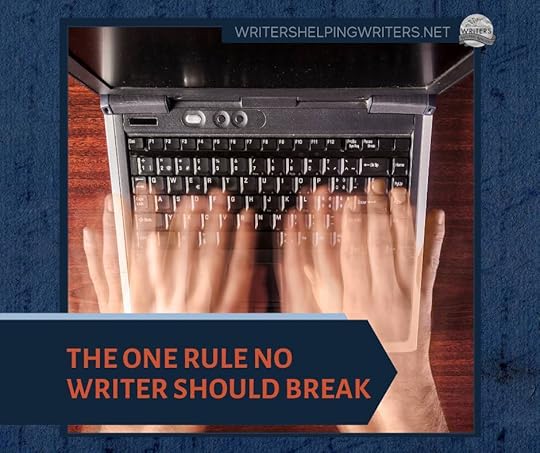
Ah, the euphoria of holding one���s own book. Nothing compares, does it? In that moment, the months (or years) of writing, revising, editing, polishing, and finally publishing are in the rear view mirror. All we know is the joy of seeing our hard work compressed into pages and fitted with a stunning cover.
We dream of happy readers, bestseller lists, and maybe even awards. And we can have these things…if we haven’t broken the cardinal rule of publishing.
As someone who studies storytelling from all angles, I can spot quickly when the cardinal rule has been broken, and every time, it guts me. Each book starts with untapped potential, ripe with the imagination of its creator, ready to bring something new and fresh to readers. But this one rule, when it’s broken, limits a book’s potential, keeping it from being all it can be.
So, what is this cardinal rule that stands above all others?
Don’t RushStories take time to write, and even longer to refine, especially as we’re all developing writers. We each have strengths and weaknesses and are building our skills as we go. Sometimes we don’t know what we don’t know, and so may not be the best judge as to whether a story is ready to move forward.
And yet, I see writers rush toward publication, skipping some of the necessary steps to ensure their book is as strong as it can be. And unfortunately, it ends the same way – a book that wasn’t ready, and the author feeling disappointment and disillusionment when their novel fails to gain traction with readers.
Rushing Burns Bridges
With more books than people on the planet, readers have endless choices. So, the very best thing we can do is give them an amazing experience when they pick up our book, because when we do, they’ll be back for more. But if we rush and the quality isn’t there, readers notice. Not only is it unlikely they’ll stick with us as an author, but they may also leave poor reviews that dissuade others from taking a chance on our book, too.
Rushing also hurts if we’re on the hunt for an agent or publisher. If we submit something that’s clearly not ready, that’s the end of the road with that agent or editor. And what if they remember us and our rushed manuscript if we submit to them down the road���will they be less inclined to ask for sample pages?
Rushing Can Be ExpensiveWhen we rush, we seek out editing before a story is ready for it, meaning costs go up as there’s more to fix. A reputable editor should let the writer know if the project is not ready before they get in too deep, but this is an ethical line that you can���t count on everyone to follow. And if a writer doesn’t carefully vet their editor, they might end up with someone who isn’t skilled enough to offer the level of help needed yet is happy to keep billing round after editing round.
Most of us must budget carefully when it comes to our writing, and editing costs that balloon can fill us with frustration and guilt and may cause us to question our choice of pursuing this path.
Rushing Can Open Us to Scams
All careers require time, effort, and training to become great at them. But unfortunately, we can forget this when it comes to writing. Maybe we think having an abundance of imagination and our creativity will carry us through, or a past career where we wrote a lot on the job makes us believe we can zip through the learning curve. Here’s the thing – imagination requires craft to apply it well, and writing and storytelling are two different skill sets. Believing there’s an easy route to publishing opens us to scams.
There are plenty of vanity publishers and other “assisted publishing” businesses that make big promises to do all the work the writer doesn’t want to do. Because their business model is to make money from writers, not the sale of books, they don’t care about the product. Writers end up shelling out huge dollars for something subpar and are often locked into contracts where they are required to also purchase a large quantity of their books themselves.
Rushing Can Damage Self-EsteemWhen we query or self-publish before we’re ready, the results won’t be what we hoped for, and this can cause us to feel inadequate. When our self-belief plummets, it can steal our energy and make it harder for us to pivot or rebound from mistakes and failures. And even when we write great books, mistakes and failures come with the territory, so we need to learn how to process these moments and learn from them.
If we’re always beating ourselves up for every misstep, we’ll eventually decide we aren’t cut out for this career. And we are! Each of us is capable of learning what we need to know to write amazing stories and steer ourselves toward a fulfilling career.
Bottom line: there is no easy button when it comes to a quality book and successful career. Prepare to work hard and open yourself to learning all you can.
Pressure to rush is something we all understandbut must resist.
When other writers are pounding out stories and getting them out into the world, we think we need to be doing the same, forgetting that we’re all in different stages of development, and each journey to publication will be unique.
When we give ourselves the space and time to write the strongest story we can, it may take longer, but our chances of pleasing readers will go way up. And we grow through the process, gaining new knowledge and refining our abilities, which will help us become masterful storytellers.
So, embrace the learning curve and enjoy the journey! It���s there to help, not stand in your way.
Help for Anti-Rushers:
How to Write a Book From Start to Finish in 13 Steps
Self-Editing Your Own Writing
Story Feedback: Free and Paid Options
Critique Etiquette: The Ultimate Guide for Giving and Receiving Feedback
When Am I Ready for Professional Editing?
Best Practices for Working with a Professional Editor
How to Navigate Editorial Feedback and Revise Your WIP
The post The One Rule No Writer Should Break appeared first on WRITERS HELPING WRITERS��.
January 20, 2024
Character Type & Trope Thesaurus: Phony Politician
In 1959, Carl Jung first popularized the idea of archetypes���”universal images that have existed since the remotest times.” He posited that every person is a blend of these 12 basic personalities. Ever since then, authors have been applying this idea to fictional characters, combining the different archetypes to come up with interesting new versions. The result is a sizable pool of character tropes that we see from one story to another.
Archetypes and tropes are popular storytelling elements because of their familiarity. Upon seeing them, readers know immediately who they’re dealing with and what role the nerd, dark lord, femme fatale, or monster hunter will play. As authors, we need to recognize the commonalities for each trope so we can write them in a recognizable way and create a rudimentary sketch for any character we want to create.
But when it comes to characters, no one wants just a sketch; we want a vibrant and striking cast full of color, depth, and contrast. Diving deeper into character creation is especially important when starting with tropes because the blessing of their familiarity is also a curse; without differentiation, the characters begin to look the same from story to story.
But no more. The Character Type and Trope Thesaurus allows you to outline the foundational elements of each trope while also exploring how to individualize them. In this way, you’ll be able to use historically tried-and-true character types to create a cast for your story that is anything but traditional.

DESCRIPTION: This character is the stereotypical politician. Charming, hypocritical, morally flexible, and often corrupt, they’ll say and do anything to get votes.
FICTIONAL EXAMPLES: Greg Stillson (The Dead Zone), William “Boss” Tweed (Gangs of New York), Frank Underwood (House of Cards), Mayor Richard Wilkins (Buffy the Vampire Slayer)
COMMON STRENGTHS: Adaptable, Ambitious, Analytical, Calm, Charming, Confident, Decisive, Diplomatic, Enthusiastic, Extroverted, Focused, Friendly, Funny, Intelligent, Observant, Persistent, Persuasive, Resourceful, Socially Aware
COMMON WEAKNESSES: Cocky, Cowardly, Dishonest, Disloyal, Evasive, Hypocritical, Lazy, Manipulative, Self-Indulgent, Selfish, Sleazy, Unethical, Vain, Verbose, Vindictive, Weak-Willed
ASSOCIATED ACTIONS, BEHAVIORS, AND TENDENCIES
Being charismatic
Speaking eloquently
Knowing what they want and being singularly focused on those goals
Instinctively knowing what to say and how to say it
Thinking strategically and analytically
Deftly working a room
Adaptability; being able to think on their feet
Speaking ambiguously so they can be flexible in their pursuits
Using scapegoats as fall guys when things go south
Working hard to keep potentially harmful past events buried
SITUATIONS THAT WILL CHALLENGE THEM
Facing public backlash and personal repercussions (such as a spouse leaving them) for their corrupt actions
Encountering a legitimate opponent who is both competent and ethical
Losing key allies or political leverage
TWIST THIS TROPE WITH A CHARACTER WHO���
Has a secret desire for redemption and engages in small acts of kindness to “balance the scales” for their behavior
Has noble motivations behind their unethical actions
Has an atypical trait: subservient, grumpy, idealistic, introverted, quirky, etc.
CLICH��S TO BE AWARE OF
The behind-the-scenes puppet master who uses manipulation and seduction to achieve their nefarious ends
Cardboard baby-kissing politicians who are obviously fake, but no one seems to notice
Other Type and Trope Thesaurus entries can be found here.
 Need More Descriptive Help?
Need More Descriptive Help?While this thesaurus is still being developed, the rest of our descriptive collection (16 unique thesauri and growing) is accessible through the One Stop for Writers THESAURUS database.
If you like, swing by and check out the video walkthrough for this site, and then give our Free Trial a spin.
The post Character Type & Trope Thesaurus: Phony Politician appeared first on WRITERS HELPING WRITERS��.
Writers Helping Writers
- Angela Ackerman's profile
- 1022 followers



